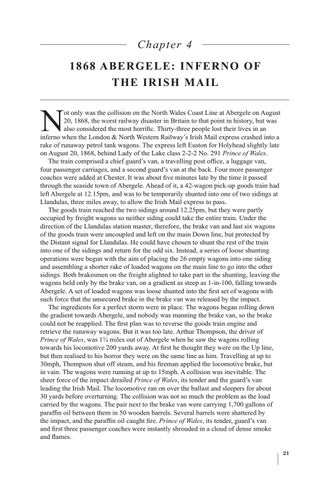C ha p t e r 4 1868 Abe rg e le: I nf er n o of th e Ir I sh M A I l
N
ot only was the collision on the North Wales Coast Line at Abergele on August 20, 1868, the worst railway disaster in Britain to that point in history, but was also considered the most horrific. Thirty-three people lost their lives in an inferno when the London & North Western Railway’s Irish Mail express crashed into a rake of runaway petrol tank wagons. The express left Euston for Holyhead slightly late on August 20, 1868, behind Lady of the Lake class 2-2-2 No. 291 Prince of Wales. The train comprised a chief guard’s van, a travelling post office, a luggage van, four passenger carriages, and a second guard’s van at the back. Four more passenger coaches were added at Chester. It was about five minutes late by the time it passed through the seaside town of Abergele. Ahead of it, a 42-wagon pick-up goods train had left Abergele at 12.15pm, and was to be temporarily shunted into one of two sidings at Llandulas, three miles away, to allow the Irish Mail express to pass. The goods train reached the two sidings around 12.25pm, but they were partly occupied by freight wagons so neither siding could take the entire train. Under the direction of the Llandulas station master, therefore, the brake van and last six wagons of the goods train were uncoupled and left on the main Down line, but protected by the Distant signal for Llandulas. He could have chosen to shunt the rest of the train into one of the sidings and return for the odd six. Instead, a series of loose shunting operations were begun with the aim of placing the 26 empty wagons into one siding and assembling a shorter rake of loaded wagons on the main line to go into the other sidings. Both brakesmen on the freight alighted to take part in the shunting, leaving the wagons held only by the brake van, on a gradient as steep as 1-in-100, falling towards Abergele. A set of loaded wagons was loose shunted into the first set of wagons with such force that the unsecured brake in the brake van was released by the impact. The ingredients for a perfect storm were in place. The wagons began rolling down the gradient towards Abergele, and nobody was manning the brake van, so the brake could not be reapplied. The first plan was to reverse the goods train engine and retrieve the runaway wagons. But it was too late. Arthur Thompson, the driver of Prince of Wales, was 1¾ miles out of Abergele when he saw the wagons rolling towards his locomotive 200 yards away. At first he thought they were on the Up line, but then realised to his horror they were on the same line as him. Travelling at up to 30mph, Thompson shut off steam, and his fireman applied the locomotive brake, but in vain. The wagons were running at up to 15mph. A collision was inevitable. The sheer force of the impact derailed Prince of Wales, its tender and the guard’s van leading the Irish Mail. The locomotive ran on over the ballast and sleepers for about 30 yards before overturning. The collision was not so much the problem as the load carried by the wagons. The pair next to the brake van were carrying 1,700 gallons of paraffin oil between them in 50 wooden barrels. Several barrels were shattered by the impact, and the paraffin oil caught fire. Prince of Wales, its tender, guard’s van and first three passenger coaches were instantly shrouded in a cloud of dense smoke and flames. 21

